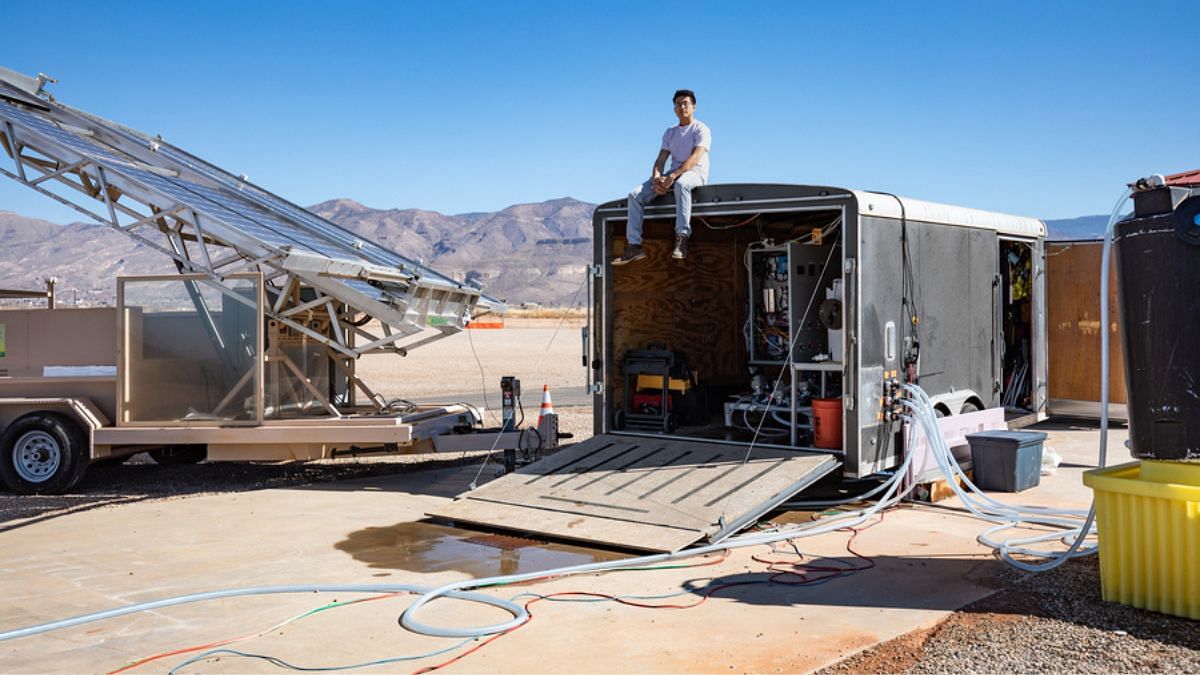New Delhi: Engineers from the Massachusetts Institute of Technology (MIT) have created a system that uses solar power to turn salty groundwater into safe drinking water, without a battery. Their research, published Tuesday in Nature Water, explains how the system adjusts to changing sunlight conditions throughout the day to purify water efficiently.
“Being able to make drinking water with renewables, without requiring battery storage, is a massive grand challenge. And we’ve done it,” said Amos Winter, co-author of the study, and mechanical engineering professor and director of MIT’s K. Lisa Yang Global Engineering and Research (GEAR) Center in a statement.
Desalination, the process of removing salts from seawater to make it drinkable, has gained significant importance over the past two decades, according to a 2019 study published in Science of The Total Environment. It suggests that desalination is becoming more popular due to the increasing problem of water scarcity, which is expected to affect 60 percent of the global population by 2025.
According to the United Nations University scientists who undertook this research, removing salts from seawater is not a practical solution for most people who live far from the coast. Many inland families rely heavily on groundwater for drinking, but this water is becoming saltier due to climate change. As groundwater becomes more saline, finding clean water is a growing challenge for communities that depend on desalinated water to meet their water needs.
This is what makes the creation of the solar-powered system disruptive.“This technology could bring sustainable, affordable clean water to underreached places around the world,” said Jonathan Bessette, PhD student at MIT and a co-author of the new paper.
Also Read: Circular trash economy in sight, how Hyderabad project reclaims metals, converts waste to energy
Simpler control system enables battery-free operation
To remove salt from brackish groundwater, MIT scientists used reverse osmosis and electrodialysis, both of which need energy. In reverse osmosis, salty water is forced through a filter that removes most of the salt, making it safe to drink. Electrodialysis, on the other hand, uses electric currents to pull charged salt particles out of the water by passing it over materials, called ion exchangers, that attract these particles.
In order to reduce greenhouse gas emissions from energy-intensive desalination, scientists have explored using renewable energy sources for generating electricity. However, this is difficult with reverse osmosis systems, which need a steady power supply—something that’s hard to achieve with variable sources like solar power.
In a study earlier this year, Winter and his team had focused on using electrodialysis and worked on making it adaptable, allowing the system to adjust to changes in sunlight throughout the day. They managed to adjust water production based on sunlight variations, using a model-based control system. They predicted the optimal water flow rate and the voltage needed to remove the most salt from the water. These predictions were made using sensors connected to each component of the system—water pumps, ion exchange membranes and solar panels.
However, this electrodialysis system required further improvement due to a slow response time, which needed energy stored in costly batteries upon the sudden appearance of clouds.
“We could only calculate every three minutes, and in that time, a cloud could literally come by and block the sun,” said Winter. “The system could be saying, ‘I need to run at this high power.’ But some of that power has suddenly dropped because there’s now less sunlight. So, we had to make up that power with extra batteries.”
This time, Bessette, Winter and their colleague Shane Pratt designed a new system that reduces the response time and eliminates the need for batteries.
They introduced a simpler control strategy called “flow-commanded current control”. This new automated version senses how much solar power is being produced and quickly adjusts the water pumps and electric current to match it.
If there’s extra power, it automatically increases water flow and electrical current to remove more salt as the water flows faster through the system. This controlled battery-less system maximises the use of solar energy, producing huge amounts of clean water despite variations in sunlight throughout the day.
The way forward
The engineers successfully tested a community-scale prototype of these battery-free new versions, that produced up to 5,000 litres of water per day, even with changing weather and sunlight conditions. The fully automated system treated brackish groundwater in New Mexico over six months and used more than 94% of the solar energy generated by its panels, compared to just 71% in the previous version designed by Winter’s team.
“Compared to how you would traditionally design a solar desal system, we cut our required battery capacity by almost 100 percent,” Winter said in a statement.
The team now plans to launch a company based on this technology in the upcoming months.
However, before the launch they intend to further test the product to maximise reliability and scale up the system to meet the needs of larger communities, including whole municipalities.
“While this is a major step forward, we’re still working diligently to continue developing lower cost, more sustainable desalination methods,” Bessette said.
(Edited by Mannat Chugh)
Also Read: Chinese scientists see sweet success, reverse type-1 diabetes in woman using her own stem cells

